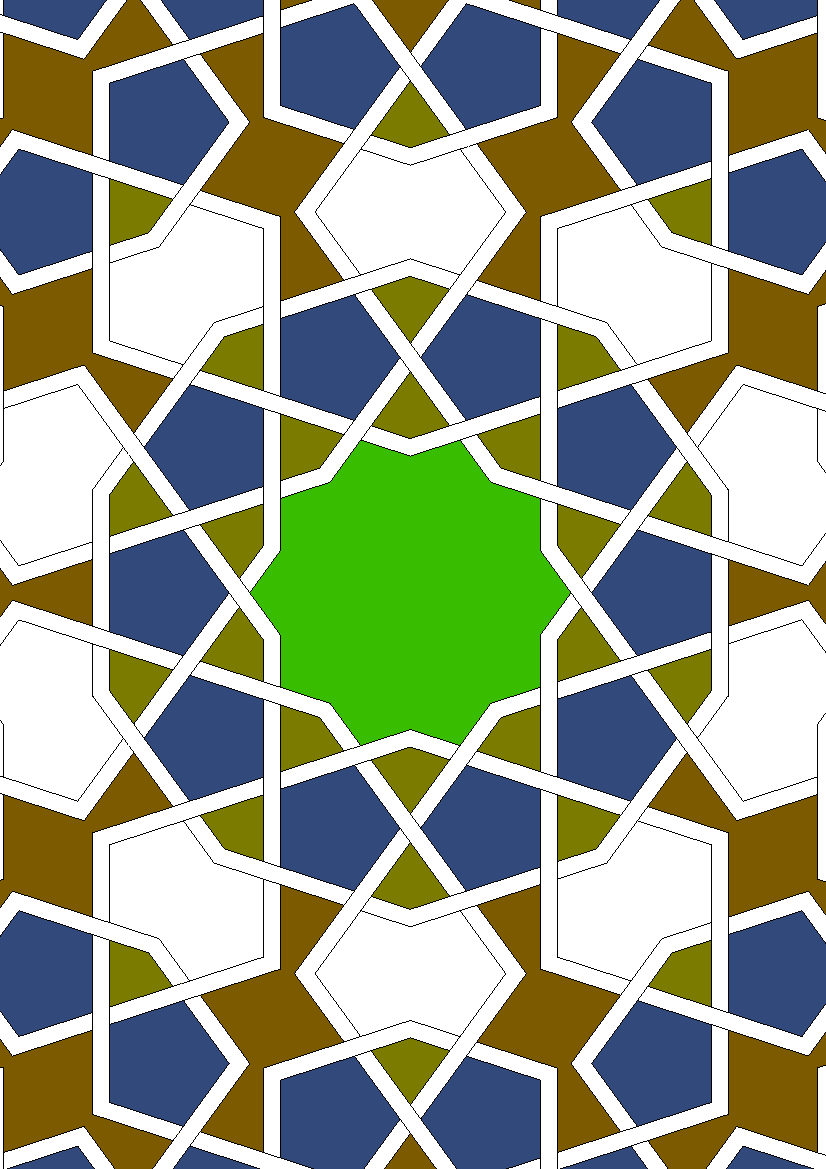

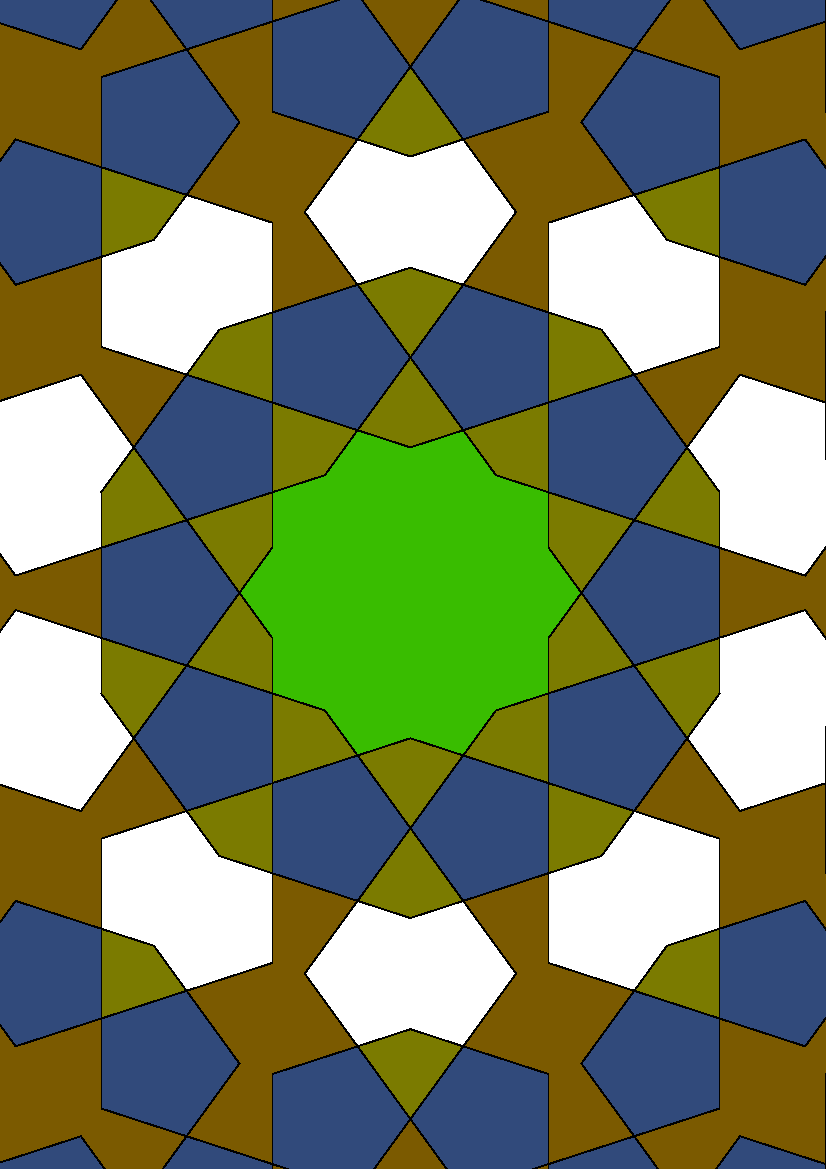
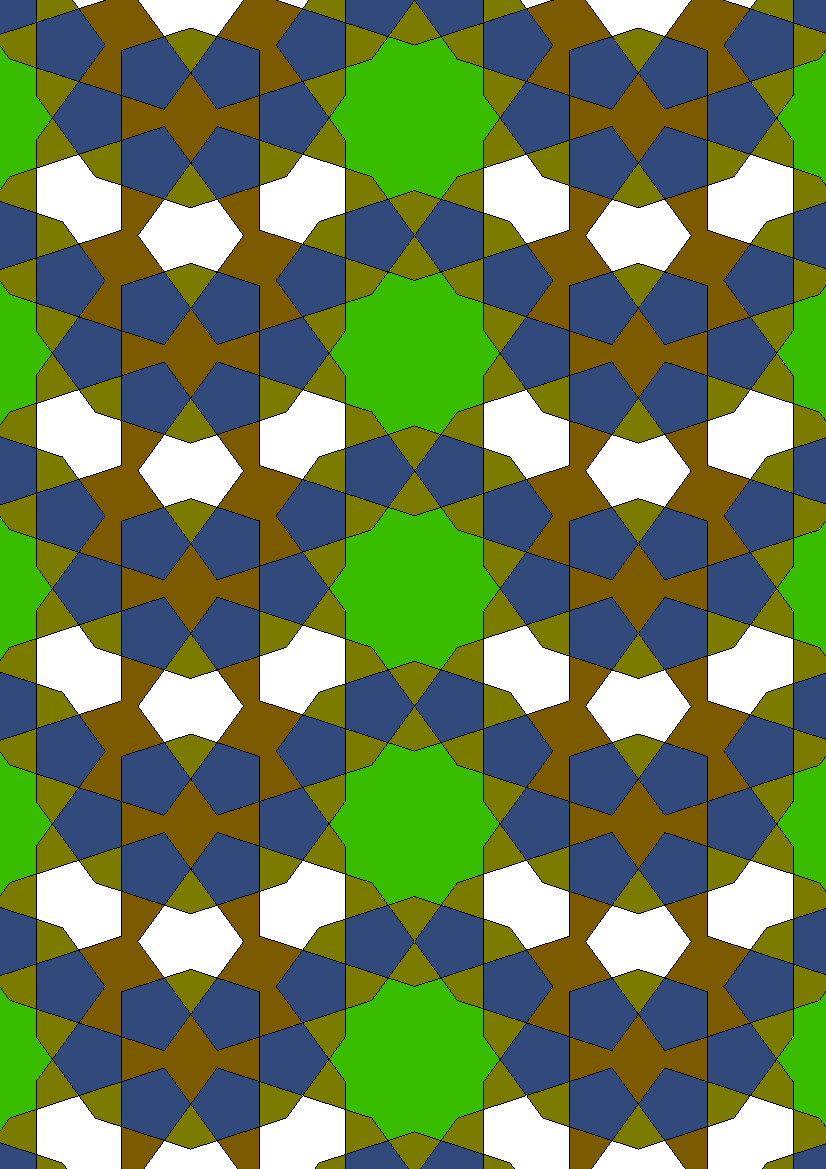
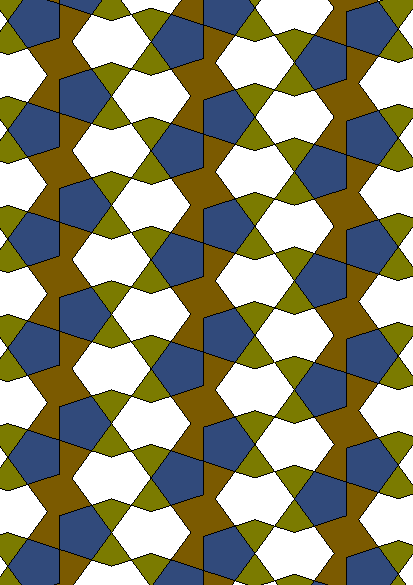
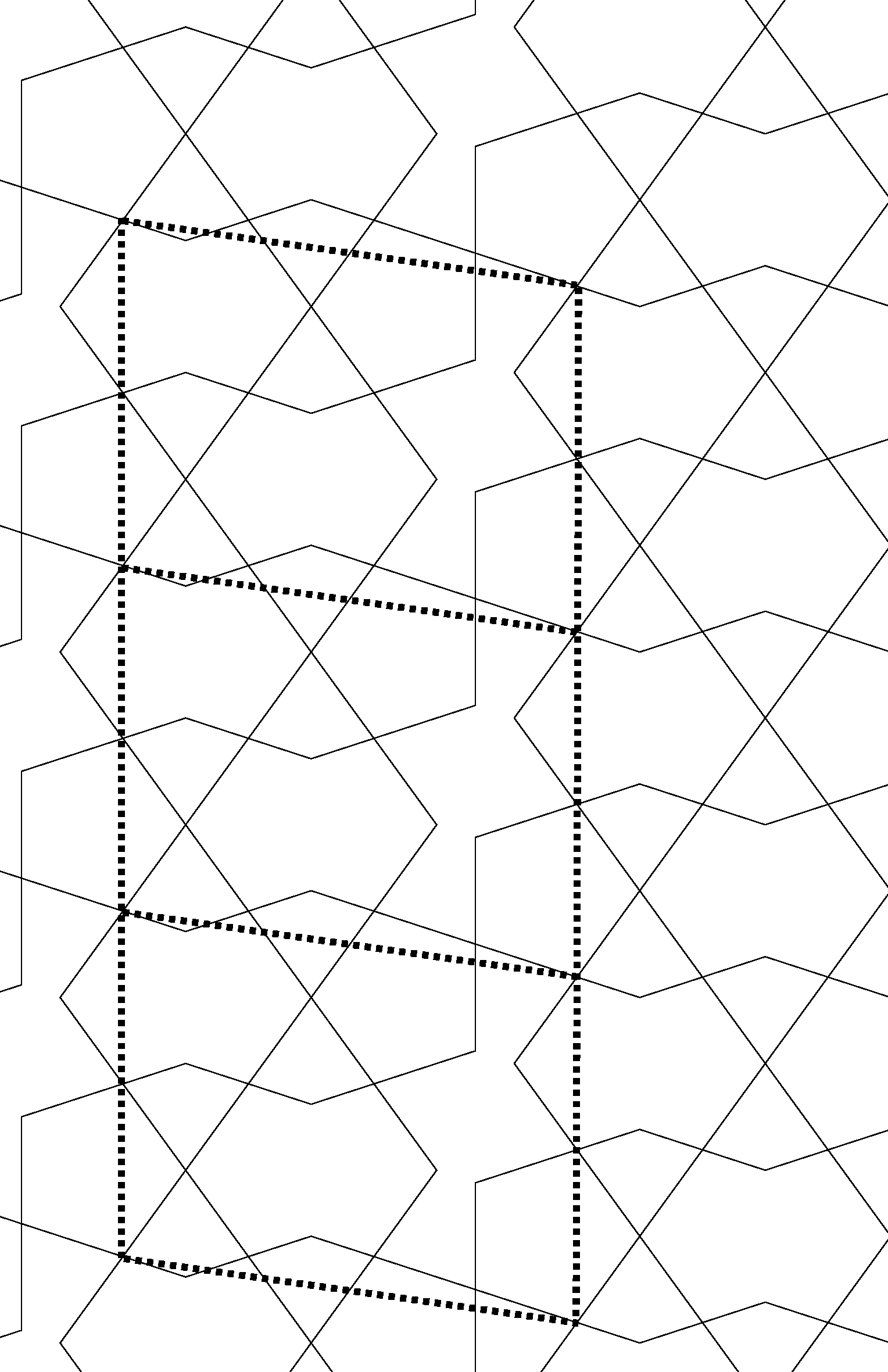
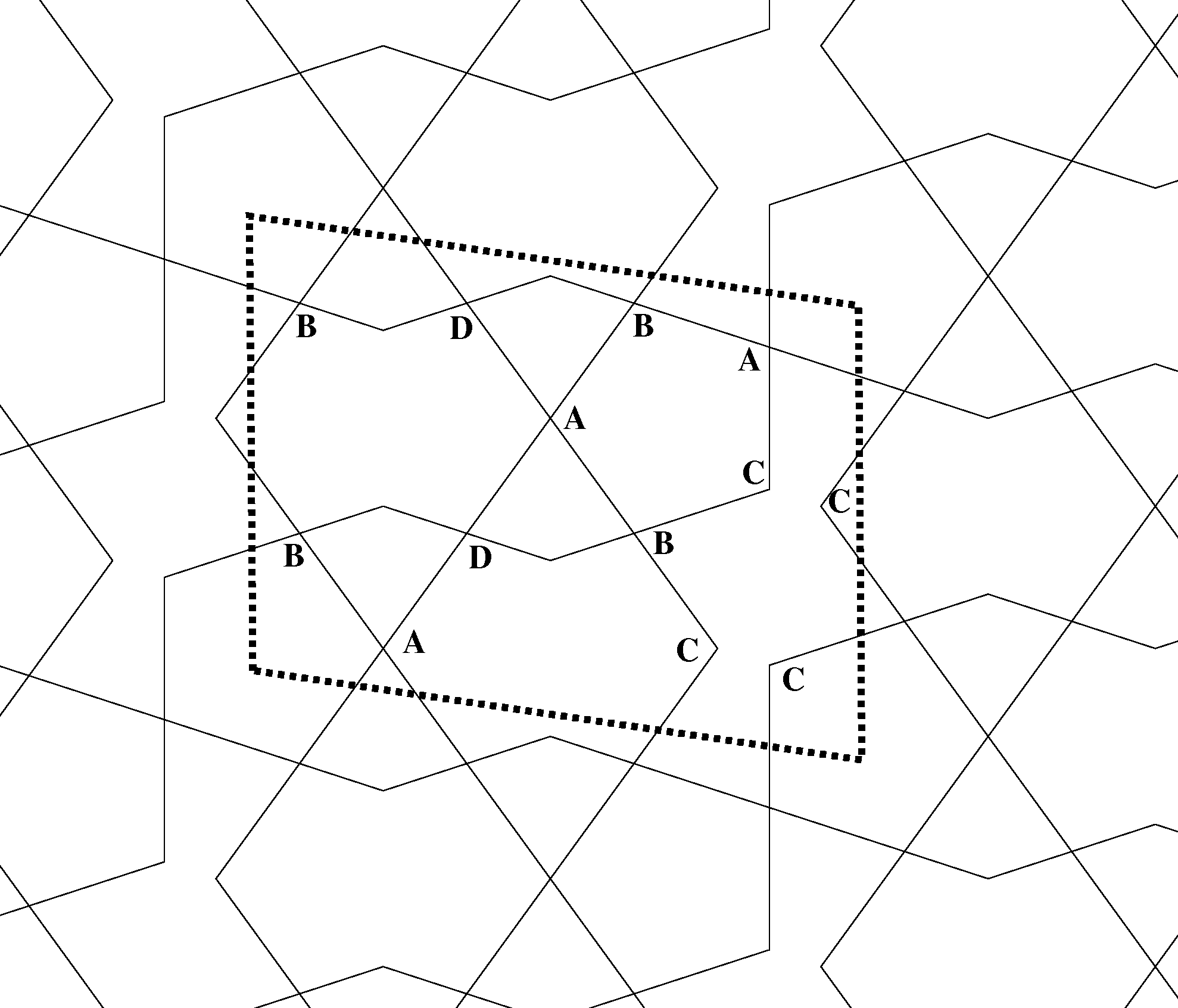
| acute corners | 2a + b = 2r + 6q | (1) |
| obtuse corners | 2a + b + c = 2r + 5p | (2) |
| re-entrant corners | c = 4q | (3) |
| straight corners | b + 2d = 4r | (4) |

| Symmetry | 8-gon | 10-gon | Interlacing | Name |
| cm | [ 1/2], 1 | 1, 2, D | 0,3 | TRY54 |
| cm | 1, 2 | [ 3/2], 3, BD | 1,0 | TRY43 |
| cm | [ 3/2], 3 | 1, 2, B | 1,0 | TRY42 |
| cm | [ 3/2], 3 | [ 5/2], 5, ACD | 1,0 | TRY46 |
| cm | 2, 3 | 2, 4, DD | 1,1 | TRY37 |
| cm | 2, 3 | 4, 5, AACD | 2,1 | TRY60 |
| cm | 2, 3 | 4, 5, AACD | 1,1 | TRY62 |
| cmm | [ 1/4], 1 | [ 3/4], 3, AA | 1,1 | TRY80 |
| cmm | [ 1/2], 1 | [ 3/4], 3, AB | 1,1 | TRY16 |
| cmm | [ 1/2], 1 | [ 5/4], 3, AAB | 3,0 | TRY26 |
| cmm | 1, 1 | [ 5/4], 3, AA | 1,2 | TRY78 |
| cmm | [ 3/2], 3 | [ 9/4], 5, AD | 3,0 | TRY79 |
| cmm | 2, 3 | 4, 5, AACD | 4,0 | TRY68 |
| cmm | 2, 3 | 4, 5, AACD | 3,2 | TRY69 |
| cmm | 2, 3 | 4, 5, AACD | 3,0 | TRY70 |
| cmm | 2, 3 | 4, 5, AACD | 3,1 | TRY71 |
| p1 | 2, 2 | 2, 2, BD | 0,2 | TRY39 |
| p1 | 2, 2 | 4, 4, AACD | 0,1 | TRY48 |
| p2 | [ 1/2], 1 | [ 1/2], 1, B | 0,2 | TRY22 |
| p2 | [ 1/2], 1 | [ 1/2], 1, A | 0,3 | TRY20 |
| p2 | 1, 1 | [ 1/2], 1, B | 0,2 | TRY34 |
| p2 | 1, 2 | [ 1/2], 1, B | 0,1 | TRY08 |
| p2 | 1, 2 | 1, 1, D | 0,2 | TRY55 |
| p2 | 1, 2 | [ 3/2], 2, AC | 0,1 | TRY02 |
| p2 | [ 3/2], 2 | [ 1/2], 1, B | 0,2 | TRY52 |
| p2 | [ 3/2], 2 | [ 3/2], 3, AB | 1,0 | TRY04 |
| p2 | 2, 2 | [ 1/2], 1, B | 0,3 | TRY07 |
| p2 | 2, 2 | [ 1/2], 1, B | 0,2 | TRY53 |
| p2 | 2, 2 | 4, 4, AACD | 3,1 | TRY49 |
| p2 | 2, 2 | 4, 4, AACD | 1,2 | TRY58 |
| p2 | 2, 2 | 4, 4, AACD | 1,2 | TRY61 |
| p2 | 3, 3 | 4, 3, ACCD | 2,2 | TRY09 |
| p2 | 3, 3 | 4, 3, ABCC | 2,1 | TRY03 |
| pg | 1, 1 | 1, 2, D | 0,3 | TRY40 |
| pg | 1, 2 | 1, 1, A | 0,4 | TRY41 |
| pg | 2, 3 | 4, 5, AACD | 0,1 | TRY56 |
| pg | 2, 3 | 4, 5, AACD | 0,2 | TRY59 |
| pgg | [ 1/2], 2 | [ 1/2], 2, B | 1,0 | TRY00 |
| pgg | [ 1/2], 2 | 1, 1, A | 0,2 | TRY06 |
| pgg | 1, 2 | [ 1/2], 2, B | 0,2 | TRY25 |
| pgg | 2, 3 | 4, 5, AACD | 1,2 | TRY64 |
| pgg | 2, 3 | 4, 5, AACD | 1,1 | TRY67 |
| pgg | 2, 3 | 4, 5, AACD | 0,2 | TRY76 |
| pm | 2, 3 | 2, 4, BD | 0,3 | TRY36 |
| pm | 2, 3 | 3, 5, ABDD | 1,1 | TRY45 |
| pm | 2, 3 | 4, 5, AACD | 3,0 | TRY51 |
| pm | 2, 3 | 4, 5, AACD | 1,1 | TRY57 |
| pmg | [ 1/2], 1 | [ 1/2], 2, B | 0,3 | TRY23 |
| pmg | [ 1/2], 1 | 1, 3, AB | 0,2 | TRY77 |
| pmg | [ 1/2], 2 | [ 1/2], 1, A | 0,2 | TRY21 |
| pmg | 1, 3 | [ 1/2], 2, B | 0,1 | TRY35 |
| pmg | 1, 1 | [ 3/2], 3, AB | 0,4 | TRY27 |
| pmg | 2, 3 | 4, 5, AACD | 3,0 | TRY65 |
| pmg | 2, 3 | 4, 5, AACD | 3,0 | TRY63 |
| pmg | 2, 3 | 4, 5, AACD | 2,2 | TRY72 |
| pmg | 2, 3 | 4, 5, AACD | 3,0 | TRY73 |
| pmg | 2, 3 | 4, 5, AACD | 1,2 | TRY74 |
| pmg | 2, 3 | 4, 5, AACD | 1,2 | TRY75 |
| pmg | 3, 3 | 4, 3, AABC | 2,1 | TRY14 |
| pmm | 1, 1 | [ 3/2], 3, AAB | 1,1 | TRY38 |
| pmm | 2, 3 | 4, 5, AACD | 5,0 | TRY50 |
|
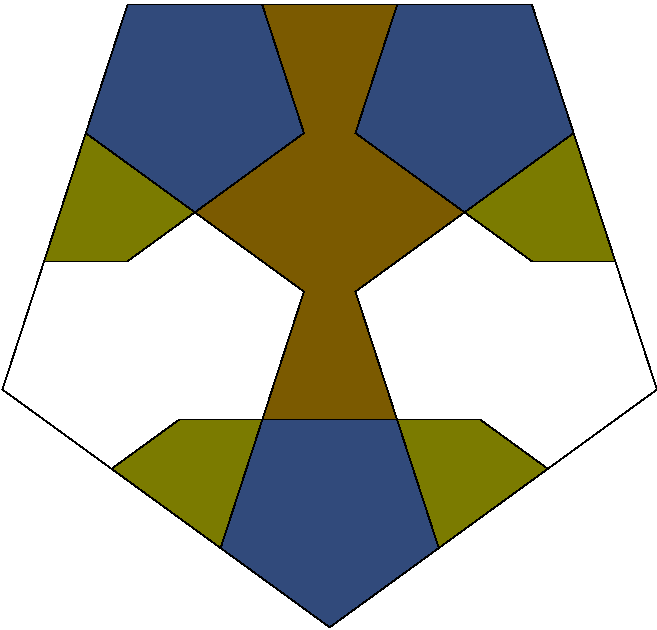
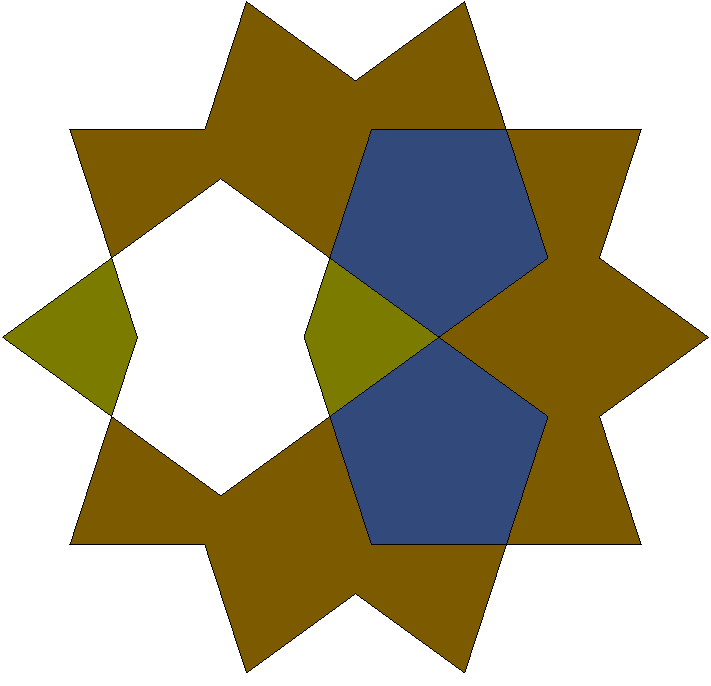
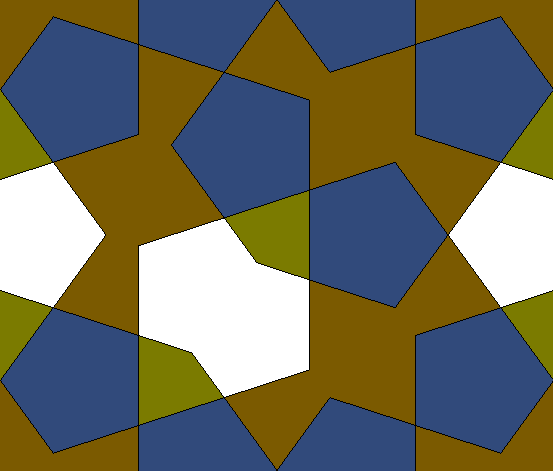
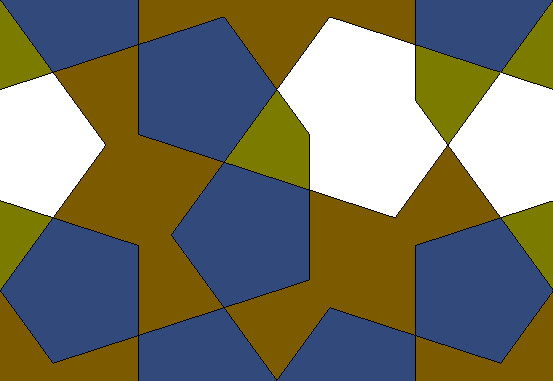
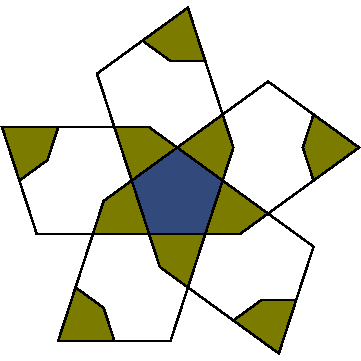
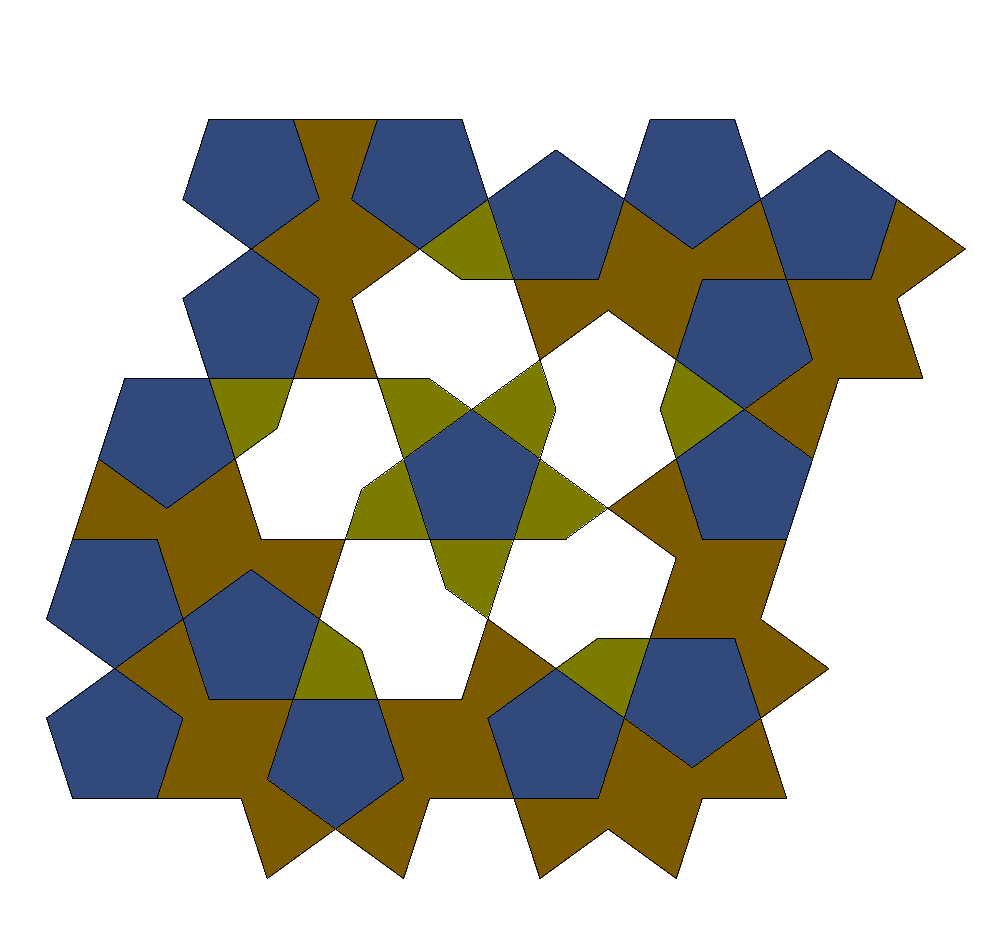
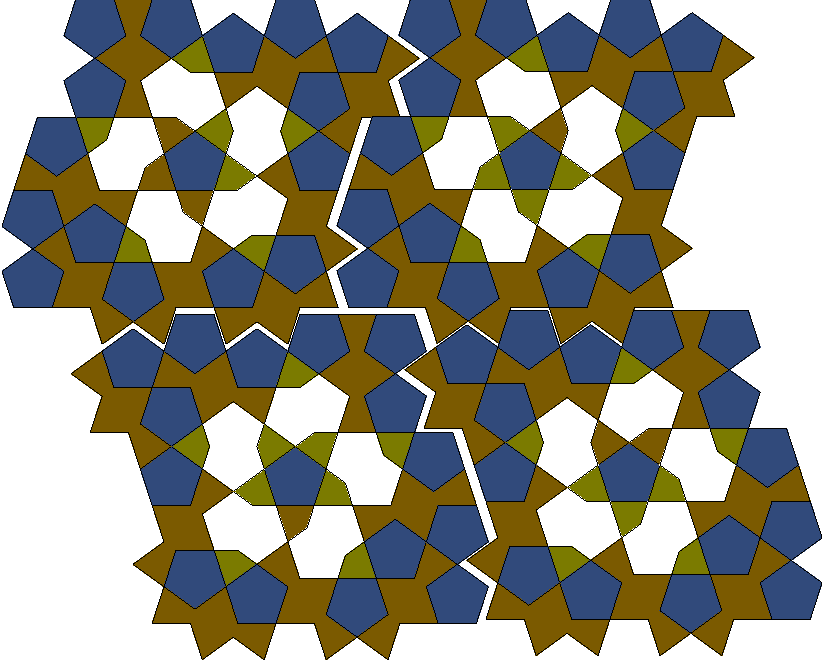
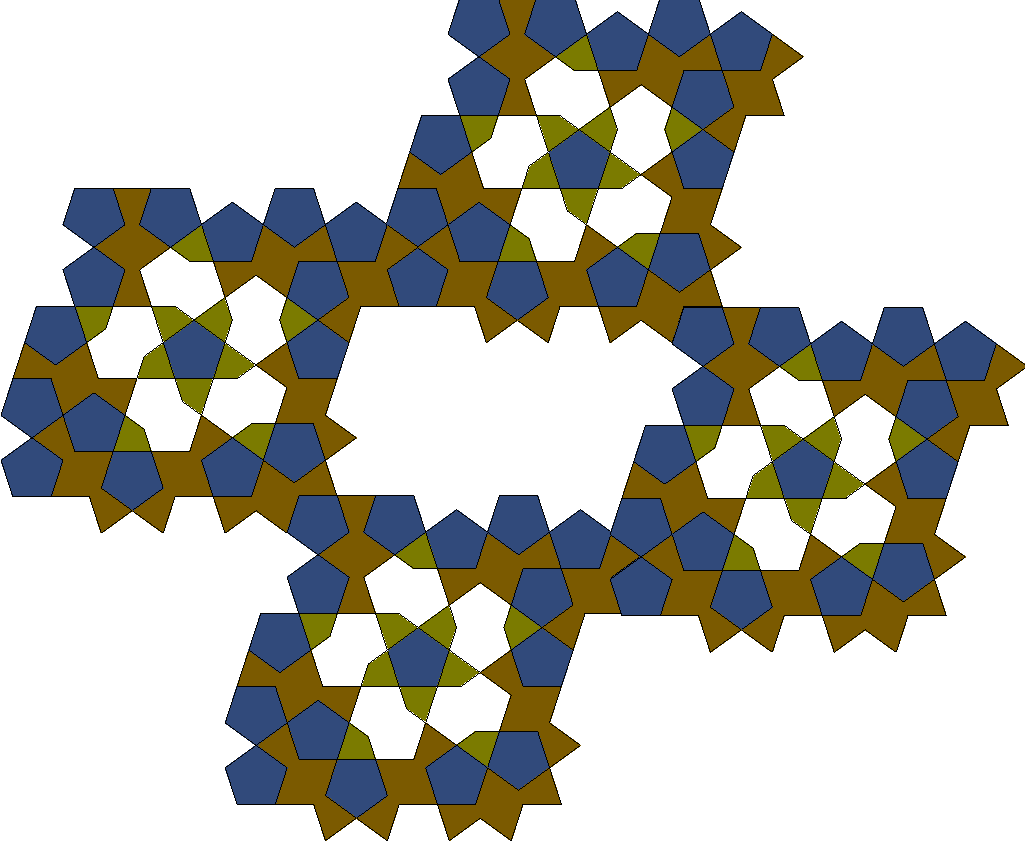
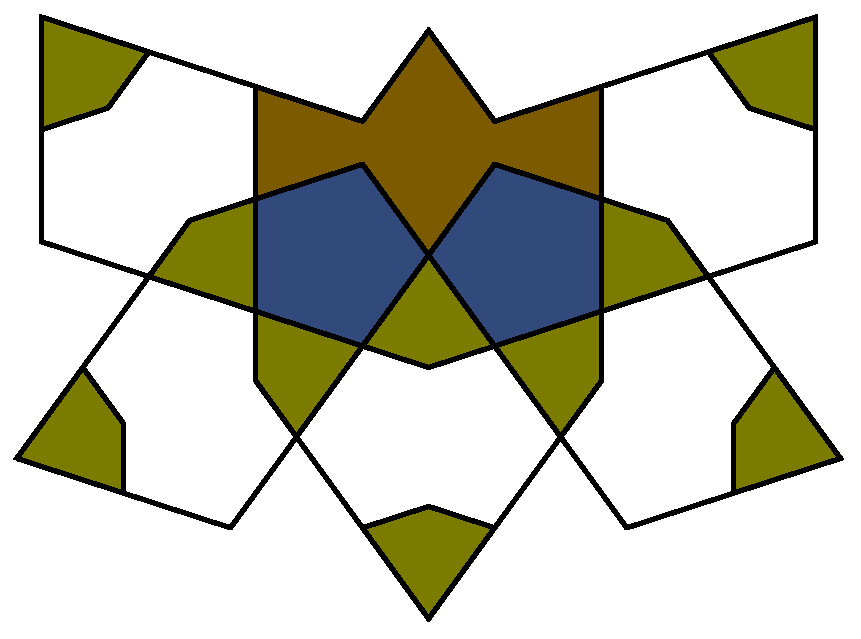
| 8-gon | ||||||
| 10-gon | [ 1/4] | [ 1/2] | 1 | [ 3/2] | 2 | 3 |
| [ 1/2] | 5 | 4 | 1 | 2 | ||
| [ 3/4] | 1 | |||||
| 1 | 1 | 3 | 3 | 1 | ||
| [ 5/4] | 1 | 1 | ||||
| [ 3/2] | 4 | 1 | ||||
| 2 | 3 | |||||
| [ 9/4] | 1 | |||||
| [ 5/2] | 1 | |||||
| 3 | 1 | |||||
| 4 | 24 | 3 | ||||
| Symmetry | G & S class | Incidence symbol | Name |
| p1 | IH41 | [a+b+c+d+;c+d+a+b+] | TRY48 |
| pm | IH42 | [a+b+c+d+;c+b-a+d-] | TRY51 |
| pm | IH42 | [a+b+c+d+;a-d+c-b+] | TRY57 |
| pg | IH43 | [a+b+c+d+;c+d-a+b-] | TRY56 |
| pg | IH43 | [a+b+c+d+;c-d+a-b+] | TRY59 |
| cm | IH45 | [a+b+c+d+;c-b-a-d-] | TRY60 |
| cm | IH45 | [a+b+c+d+;a-d-c-b-] | TRY62 |
| p2 | IH46 | [a+b+c+d+;a+b+c+d+] | TRY58 |
| p2 | IH47 | [a+b+c+d+;c+b+a+d+] | TRY49 |
| p2 | IH47 | [a+b+c+d+;a+d+c+b+] | TRY61 |
| pmm | IH48 | [a+b+c+d+;a-b-c-d-] | TRY50 |
| pmg | IH49 | [a+b+c+d+;a-b+c-d+] | TRY63 |
| pmg | IH49 | [a+b+c+d+;a+b-c+d-] | TRY72 |
| pmg | IH50 | [a+b+c+d+;c+b-a+d+] | TRY65 |
| pmg | IH50 | [a+b+c+d+;c+b+a+d-] | TRY73 |
| pmg | IH50 | [a+b+c+d+;a-d+c+b+] | TRY74 |
| pmg | IH50 | [a+b+c+d+;a+d+c-b+] | TRY75 |
| pgg | IH51 | [a+b+c+d+;c-b+a-d+] | TRY48 |
| pm | IH42 | [a+b+c+d+;c+b-a+d-] | TRY51 |
| pm | IH42 | [a+b+c+d+;a-d+c-b+] | TRY57 |
| pg | IH43 | [a+b+c+d+;c+d-a+b-] | TRY56 |
| pg | IH43 | [a+b+c+d+;c-d+a-b+] | TRY59 |
| cm | IH45 | [a+b+c+d+;c-b-a-d-] | TRY60 |
| cm | IH45 | [a+b+c+d+;a-d-c-b-] | TRY62 |
| p2 | IH46 | [a+b+c+d+;a+b+c+d+] | TRY58 |
| p2 | IH47 | [a+b+c+d+;c+b+a+d+] | TRY49 |
| p2 | IH47 | [a+b+c+d+;a+d+c+b+] | TRY61 |
| pmm | IH48 | [a+b+c+d+;a-b-c-d-] | TRY50 |
| pmg | IH49 | [a+b+c+d+;a-b+c-d+] | TRY63 |
| pmg | IH49 | [a+b+c+d+;a+b-c+d-] | TRY72 |
| pmg | IH50 | [a+b+c+d+;c+b-a+d+] | TRY65 |
| pmg | IH50 | [a+b+c+d+;c+b+a+d-] | TRY73 |
| pmg | IH50 | [a+b+c+d+;a-d+c+b+] | TRY74 |
| pmg | IH50 | [a+b+c+d+;a+d+c-b+] | TRY75 |
| pgg | IH51 | [a+b+c+d+;c-b+a-d+] | TRY67 |
| pgg | IH51 | [a+b+c+d+;a+d-c+b-] | TRY76 |
| pgg | IH52 | [a+b+c+d+;c-d-a-b-] | TRY64 |
| cmm | IH54 | [a+b+c+d+;a-b-c-d+] | TRY68 |
| cmm | IH54 | [a+b+c+d+;a+b-c-d-] | TRY69 |
| cmm | IH54 | [a+b+c+d+;a-b+c-d-] | TRY70 |
| cmm | IH54 | [a+b+c+d+;a-b-c+d-] | TRY71 |
Graphics converted by GraphicConverter.